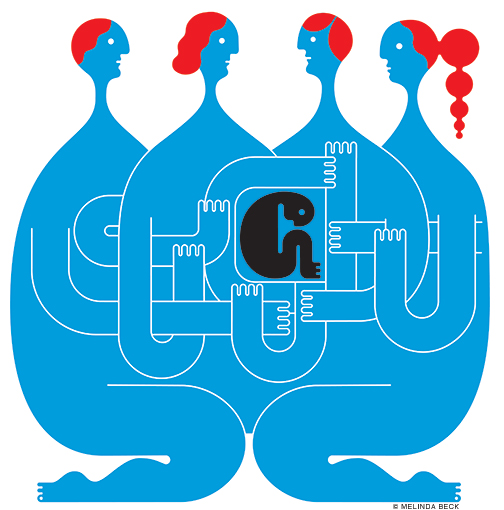The fatal scourge of child maltreatment has a tragic enabler: the ethical code of professional social workers.

By Richard J. Gelles | When Philadelphia Assistant District Attorney Ed McCann asked me if I would review materials of a case that was to be presented to a Philadelphia grand jury, I accepted with concern. I knew something about the case of 14-year-old Danieal Kelly, who died on August 4, 2006. My first knowledge of it came when our school’s associate dean for student affairs alerted me that the FBI was interviewing one of our Master of Social Work (MSW) students. When I asked for more details, I learned that our student had been assigned to Danieal’s case as part of his internship with a local social service agency. The agency, MultiEthnic Behavioral Health, owned and operated by one of the school’s graduates, was a longtime field placement for the school. I knew a little bit more from conversations with reporters from the Philadelphia Inquirer who were working on an investigation of the Philadelphia Department of Human Services (DHS).
Even with some foreknowledge, I was completely unprepared for what I read in the case materials. As detailed in the 263-page grand jury report, Danieal, who had cerebral palsy, wasted away while supposedly under the watch of DHS and MultiEthnic Behavioral Services. When she died in a urine-soaked bed, Danieal weighed 42 pounds and had bedsores that nearly reached her bones.
After the grand jury report, McCann and the District Attorney’s Office proceeded to prosecute Danieal’s parents, family friends, DHS employees, and the owner and employees of MultiEthnic Behavioral Health. In the end, 17 individuals were either convicted or pled guilty to charges ranging from perjury to third-degree murder.
As I met with McCann to prepare for my grand jury testimony, he and his associates continued to ask me the same question: How could social workers and supervisors whose job it is to protect children allow a 14-year-old to slowly starve to death? While some caseworkers had falsified their records, and recorded visits they never made, other caseworkers did visit the Kelly home and most certainly had at least peeked into Danieal’s room. And yet Danieal died a slow death in a hot, dark bedroom.
My answer probably did not convince McCann and his associates. I said that the workers—not merely the incompetent ones, but the best ones as well—tend to see parents, not children, as their primary clients. Despite the fact that the agencies are named “Child Welfare” or “Child Protection,” their real mission focuses on providing services to parents and caregivers. If there is a “fatal” flaw in the American child welfare system, it is the fact that the system does not see vulnerable children as its primary clients.
To those outside of the child welfare system, it seems almost elementary that the child should be the client, and child safety and wellbeing should be the goal. But those in the system are guided by different assumptions. The culture of the child welfare system is founded on the belief that children do best when raised by their birth parents. This culture is reinforced by the fact that professional social workers are the backbone of the child welfare system—an MSW degree is often required for those appointed to supervisory positions. And the code of the ethics of the National Association of Social Workers, read by every social work student, includes the following principle:
“Ethical Principle: Social workers challenge social injustice. Social workers pursue social change, particularly with and on behalf of vulnerable and oppressed individuals and groups of people. Social workers’ social change efforts are focused primarily on issues of poverty, unemployment, discrimination, and other forms of social injustice. These activities seek to promote sensitivity to and knowledge about oppression and cultural and ethnic diversity. Social workers strive to ensure access to needed information, services, and resources; equality of opportunity; and meaningful participation in decision making for all people.”
Given that the current model explains child abuse and neglect as a function of poverty, stress, and oppression, this axiom directly influences social workers to focus their attention on those problems, rather than simply protecting children. The professional emphasis on pursuing social change—particularly with, and on behalf of, vulnerable and oppressed individuals and groups—means that caseworkers and supervisors see parents as the actual clients of the child welfare system. This is the obvious consequence of social change efforts that focus primarily on issues of poverty, unemployment, discrimination, and other forms of social injustice.
Legal precedents also reinforce the culture of the parent-as-client. In the most important Supreme Court ruling in the child welfare field, Smith v. Organization of Foster Families for Equality and Reform (1977) , the court held that the Fourteenth Amendment gives parents a “constitutionally recognized liberty interest” in maintaining the custody of their children “that derives from blood relationship, state law sanction, and basic human right.” Of course, the right is not absolute, because of the state’s power and authority to exercise parens patriae duties to protect citizens who cannot fend for themselves. The state may attempt to limit or end parent–child contact and make children eligible for temporary or permanent placement or adoption when parents (1) abuse, neglect, or abandon their children; (2) become incapacitated in their ability to be a parent; (3) refuse or are unable to remedy serious, identified problems in caring for their children; or (4) experience an extraordinarily severe breakdown in their relationship with their children (e.g., owing to a long prison sentence).
Nevertheless, the result is a system that is reluctant to remove children from their birth parents. Caseworkers, supervisors, and administrators make every possible effort to keep or reunify maltreated children with their birth parents. Child welfare systems are also sensitive to the issue of racial disproportionality—the fact that African-American children and families are reported for child abuse and neglect more frequently than whites, and minority and African-American children are both disproportionately placed in foster care and stay longer in foster care compared to white children.
There are two important problems with the “parent-as-client” child welfare system. First, parents who maltreat their children are difficult to change. Second, the interventions that are employed by the child welfare system, such as Intensive Family Preservation Services or Family Group Conferencing, have had limited success in creating safety for maltreated children. The singular successful program is a prevention program titled Nurse Family Partnerships.
Fortunately, child fatalities such as that of Danieal Kelly are somewhat rare—there are about 2,500 child-maltreatment fatalities each year, of which approximately half involve children and families known to child welfare agencies. But the parent-as-client model also has detrimental consequences to children who suffer non-fatal maltreatment. Frankly and bluntly stated, children’s development is held hostage while child welfare agencies implement interventions in the hope that parents can and will change.
We have now more than a half-century of experience with a parent-as-client child welfare system, and the safety and wellbeing of maltreated children still cannot be ensured. It is time to set our sights on a narrower goal—which is also an achievable one. The child welfare system will never be effective unless and until it places the child as the client, makes decisions with the child’s safety and well-being as the most important consideration, and makes decisions with a child’s sense of time.





I read with interest Richard Gelles’ article “Social Justice at Children’s Expense” (“Expert Opinion,” Jul/Aug 2017). Gelles discusses the tragic death of Danieal Kelly, a child with cerebral palsy, who had received social services from an agency owned and operated by a graduate of Penn’s School of Social Policy and Practice. Gelles summarizes the criminal charges in this case; 17 individuals, including human services professionals, were either convicted or pled guilty to charges ranging from perjury to third-degree murder.
The article’s subtitle makes a bold claim: “The fatal scourge of child maltreatment has a tragic enabler: the ethical code of professional social workers.” But, the very code of ethics that Gelles cites includes explicit language—not cited by Gelles—that challenges his assertion.
In the article’s body Gelles critiques our nation’s child welfare system and the social work profession’s code of ethics: “The culture of the child welfare system is founded on the belief that children do best when raised by their birth parents. This culture is reinforced by the fact that professional social workers are the backbone of the child welfare system—an MSW degree is often required for those appointed to supervisory positions. And the code of ethics of the National Association of Social Workers, read by every social work student, includes the following principle: ‘Ethical Principle: Social workers challenge social injustice. Social workers pursue social change, particularly with and on behalf of vulnerable and oppressed individuals and groups of people. Social workers’ social change efforts are focused primarily on issues of poverty, unemployment, discrimination, and other forms of social injustice. These activities seek to promote sensitivity to and knowledge about oppression and cultural and ethnic diversity. Social workers strive to ensure access to needed information, services, and resources; equality of opportunity; and meaningful participation in decision making for all people.'”
Gelles argues that social work’s commitment to social justice—a hallmark of the profession’s mission since its formal inauguration in the late 19th century—has led to its neglect of vulnerable children and social work’s misplaced preoccupation with social change and parents’ needs: “Given that the current model explains child abuse and neglect as a function of poverty, stress, and oppression, this axiom directly influences social workers to focus their attention on those problems, rather than simply protecting children. The professional emphasis on pursuing social change—particularly with, and on behalf of, vulnerable and oppressed individuals and groups—means that caseworkers and supervisors see parents as the actual clients of the child welfare system.”
I fully agree with Gelles that the child welfare system as we know it is in dire need of reform. Overwhelmed social workers face daunting odds: They must care for the needs of remarkably vulnerable children—always the priority—while, simultaneously, facilitating the delivery of mental health, substance abuse, parenting, and other services to these children’s parents when reunification is reasonable, court ordered, or both. Too often, social workers’ caseloads are too large and the resources too lean.
Yet, I am puzzled by Gelles’ claim that the National Association of Social Workers Code of Ethics is to blame. Gelles argues that the code language he cites encourages social workers to put social change and parents first and vulnerable children second. Elsewhere in the very code Gelles cites is language that undermines his claim. The code’s very first standard (1.01) acknowledges explicitly that in some circumstances clients’ interests must be overridden by social workers’ duty to protect other individuals from harm. Indeed, this lodestar standard includes a parenthetical statement that cites child abuse, Gelles’ principal concern, as an example of an instance when clients’ interests, e.g., parents’ interests, may have to be sacrificed to protect a child: “Social workers’ primary responsibility is to promote the well-being of clients. In general, clients’ interests are primary. However, social workers’ responsibility to the larger society or specific legal obligations may on limited occasions supersede the loyalty owed clients, and clients should be so advised. (Examples include when a social worker is required by law to report that a client has abused a child or has threatened to harm self or others.)” [emphasis added]
I was privileged to have chaired the national task force that wrote this code of ethics language. I am proud of the code’s emphasis on social work’s historic and venerable commitment to social justice—a defining feature of the profession’s mission. I have been a social worker since the 1970s and an adjunct faculty member in Penn’s School of Social Policy and Practice. I have never met a social worker who interprets the code’s language to mean what Gelles suggests—that the profession’s commitment to social change should ever lead to sacrifice of social workers’ overriding obligation to protect abused and neglected children first and foremost. In my view, to conclude otherwise is to misread the code.
If I understand Dean Gelles’ argument correctly, he seems to be saying that the NASW Code of Ethics enables social workers to act in ways that are contrary to the needs of children who are being abused and neglected. In my reading of the Code of Ethics, the provisions on social justice advise social workers to act on behalf of the most vulnerable people in society. Certainly, helping children who are being maltreated would be among a social worker’s highest priorities. The purpose of the child protection system is and always has been to protect the safety and welfare of children. If some child protection workers or agencies are not doing so, then this needs to be addressed directly with them. To blame the NASW Code of Ethics for condoning dangerous or ineffective practice does not fit with the words or spirit of the Code.
Thank you for most thoughtful article. I will pass it on to various social workers that I work with